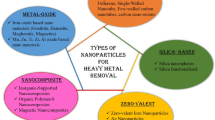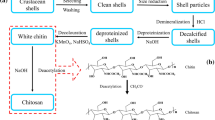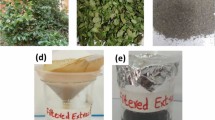Abstract
Magnetic chitosan microparticles are functionalized by grafting a new hydrazide derivative to produce HAHZ-MG-CH, which is applied to the sorption of metal cations. The functionalization (appearance of new groups) and synthesis mechanisms are confirmed using elemental analyses, FTIR and XPS spectrometry, TGA and EDX analysis, SEM observation and titration. HAHZ-MG-CH bears high nitrogen content (≈ 10.9 mmol N g−1). Maximum sorption capacities at pH 5 reach up to 1.55 mmol U g−1, 1.82 mmol Hg g−1 and 2.67 mmol Cd g−1. Sorption isotherms are preferentially fitted by the Langmuir model. In acidic solutions, the sorbent has a marked preference for Hg(II) over U(VI) and Cd(II), while at mild pH uranyl species are preferentially bound. The sorbent has a lower affinity for Cd(II) in multicomponent solutions. Sorption occurs within 60 min of contact. The pseudo-first-order rate equation fits well kinetic profiles. HCl solutions (0.5 M) successfully desorb all the metal ions (yield exceeds 97% at the first cycle). The sorbent can be recycled for 5 cycles of sorption and desorption: the loss in efficiencies does not exceed 8%. The sorbent removes Hg(II), Cd(II) and Pb(II) from local contaminated groundwater at levels compatible with irrigation and livestock uses but not enough to reach the levels for drinking water regulations.






Similar content being viewed by others

References
WHO (2011) Guidelines for drinking-water quality. World Health Organization, Geneva
Kavak D (2013) Removal of lead from aqueous solutions by precipitation: statistical analysis and modeling. Desalin Water Treat 51:1720–1726
Wilson AM, Bailey PJ, Tasker PA, Turkington JR, Grant RA, Love JB (2014) Solvent extraction: the coordination chemistry behind extractive metallurgy. Chem Soc Rev 43:123–134
Lai YC, Lee WJ, Huang KL, Wu CM (2008) Metal recovery from spent hydrodesulfurization catalysts using a combined acid-leaching and electrolysis process. J Hazard Mater 154:588–594
Otrembska P, Gega J (2016) Separation of nickel(II) and cadmium(II) ions with ion-exchange and membrane processes. Sep Sci Technol 51:2675–2680
Kabay N, Demircioglu M, Yayli S et al (1998) Recovery of uranium from phosphoric acid solutions using chelating ion-exchange resins. Ind Eng Chem Res 37:1983–1990
Cao Q, Liu Y, Kong X, Zhou L, Guo H (2013) Synthesis of phosphorus-modified poly(styrene-co-divinylbenzene) chelating resin and its adsorption properties of uranium(VI). J Radioanal Nucl Chem 298:1137–1147
Li C, Duan HD, Wang XJ, Meng X, Qin DW (2015) Fabrication of porous resins via solubility differences for adsorption of cadmium (II). Chem Eng J 262:250–259
Shao GL, Xiao JF, Tian ZH, Huang JJ, Yuan SG (2018) Preparation and characterization of polyphenylene sulfide-based chelating resin-functionalized 2-amino-1,3,4-thiadiazole for selective removal Hg(II) from aqueous solutions. Polym Adv Technol 29:1030–1038
Cai Z, Song X, Zhang Q, Liu Y (2017) Amidoxime surface modification of polyindole nanofiber membrane for effective removal of Cr(VI) from aqueous solution. J Mater Sci 52:5417–5434. https://doi.org/10.1007/s10853-017-0786-2
Chi F, Zhang S, Wen J, Xiong J, Hu S (2019) Functional polymer brushes for highly efficient extraction of uranium from seawater. J Mater Sci 54:3572–3585. https://doi.org/10.1007/s10853-018-3040-7
Yang Z, Chen G, Weng H, Shen W, Huang Z, Lin M (2018) Efficient and selective separation of U(VI) and Th(IV) from rare earths using functionalized hierarchically mesoporous silica. J Mater Sci 53:3398–3416. https://doi.org/10.1007/s10853-017-1808-9
Liu DJ, Ding CC, Chi FT et al (2019) Polymer brushes on graphene oxide for efficient adsorption of heavy metal ions from water. J Appl Polym Sci 136:48156
Wu HY, Chi FT, Zhang S, Wen J, Xiong J, Hu S (2019) Control of pore chemistry in metal-organic frameworks for selective uranium extraction from seawater. Microporous Mesoporous Mater 288:109567
Sajjadi SA, Mohammadzadeh A, Tran HN et al (2018) Efficient mercury removal from wastewater by pistachio wood wastes-derived activated carbon prepared by chemical activation using a novel activating agent. J Environ Manag 223:1001–1009
Khamirchi R, Hosseini-Bandegharaei A, Alahabadi A et al (2018) Adsorption property of Br-PADAP-impregnated multiwall carbon nanotubes towards uranium and its performance in the selective separation and determination of uranium in different environmental samples. Ecotoxicol Environ Saf 150:136–143
Carro L, Barriada JL, Herrero R, de Vicente MES (2011) Adsorptive behaviour of mercury on algal biomass: competition with divalent cations and organic compounds. J Hazard Mater 192:284–291
Sinha A, Pant KK, Khare SK (2012) Studies on mercury bioremediation by alginate immobilized mercury tolerant Bacillus cereus cells. Int Biodeterior Biodegrad 71:1–8
Dutta A, Zhou LP, Castillo-Araiza CO, De Herdt E (2016) Cadmium(II), lead(II), and copper(II) biosorption on Baker’s yeast (Saccharomyces cerevesiae). J Environ Eng 142:C6015002
Safonov A, Tregubova V, Ilin V et al (2018) Comparative study of lanthanum, vanadium, and uranium bioremoval using different types of microorganisms. Water Air Soil Pollut 229:82
Hu L-Q, Dai L, Liu R, Si C-L (2017) Lignin-graft-poly(acrylic acid) for enhancement of heavy metal ion biosorption. J Mater Sci 52:13689–13699. https://doi.org/10.1007/s10853-017-1463-1
Zhang D, Xiao J, Guo Q, Yang J (2019) 3D-printed highly porous and reusable chitosan monoliths for Cu(II) removal. J Mater Sci 54:6728–6741. https://doi.org/10.1007/s10853-019-03332-y
Wei J, Yang Z, Sun Y et al (2019) Nanocellulose-based magnetic hybrid aerogel for adsorption of heavy metal ions from water. J Mater Sci 54:6709–6718. https://doi.org/10.1007/s10853-019-03322-0
Vijayaraghavan K, Rangabhashiyam S, Ashokkumar T, Arockiaraj J (2016) Mono- and multi-component biosorption of lead(II), cadmium(II), copper(II) and nickel(II) ions onto coco-peat biomass. Sep Sci Technol 51:2725–2733
Tran HN, Chao HP (2018) Adsorption and desorption of potentially toxic metals on modified biosorbents through new green grafting process. Environ Sci Pollut Res 25:12808–12820
Vold IMN, Varum KM, Guibal E, Smidsrod O (2003) Binding of ions to chitosan—selectivity studies. Carbohydr Polym 54:471–477
Roberts GAF (1992) Chitin chemistry. The Macmillan Press Limited, London
Guibal E (2004) Interactions of metal ions with chitosan-based sorbents: a review. Sep Purif Technol 38:43–74
Giraldo JD, Rivas BL, Elgueta E, Mancisidor A (2017) Metal ion sorption by chitosan-tripolyphosphate beads. J Appl Polym Sci 134, 45511
Ruiz MA, Sastre AM, Guibal E (2002) Pd and Pt recovery using chitosan gel beads: I. Influence of drying process on diffusion properties. Sep Sci Technol 37:2143–2166
Djelad A, Morsli A, Robitzer M, Bengueddach A, di Renzo F, Quignard F (2016) Sorption of Cu(II) ions on chitosan-zeolite X composites: impact of gelling and drying conditions. Molecules 21:109
Wan M-W, Kan C-C, Rogel BD, Dalida MLP (2010) Adsorption of copper (II) and lead (II) ions from aqueous solution on chitosan-coated sand. Carbohydr Polym 80:891–899
Meng J, Cui J, Yu J et al (2018) Preparation of green chelating fibers and adsorption properties for Cd(II) in aqueous solution. J Mater Sci 53:2277–2289. https://doi.org/10.1007/s10853-017-1653-x
Javadian H, Ghaemy M, Taghavi M (2014) Adsorption kinetics, isotherm, and thermodynamics of Hg2+ to polyaniline/hexagonal mesoporous silica nanocomposite in water/wastewater. J Mater Sci 49:232–242. https://doi.org/10.1007/s10853-013-7697-7
Hamza MF, Wei Y, Mira HI, Abdel-Rahman AAH, Guibal E (2019) Synthesis and adsorption characteristics of grafted hydrazinyl amine magnetite-chitosan for Ni(II) and Pb(II) recovery. Chem Eng J 362:310–324
Hamza MF, Roux J-C, Guibal E (2018) Uranium and europium sorption on amidoxime-functionalized magnetic chitosan micro-particles. Chem Eng J 344:124–137
Hamza MF, Abdel-Rahman AAH (2015) Extraction studies of some hazardous metal ions using magnetic peptide resins. J Dispers Sci Technol 36:411–422
Mahdavinia GR, Shokri E (2017) Synthesis and characterization of magnetic amidoximated chitosan-g poly (polyacrylonitrile)/laponite RD nanocomposites with enhanced adsorption capacity for Cu2+. Turk J Chem 41:135–152
Varma AJ, Deshpande SV, Kennedy JF (2004) Metal complexation by chitosan and its derivatives: a review. Carbohydr Polym 55:77–93
Elwakeel KZ, Atia AA (2014) Uptake of U(VI) from aqueous media by magnetic Schiff’s base chitosan composite. J Clean Prod 70:292–302
Liang W, Li ML, Zhang ZQ et al (2018) Decontamination of Hg(II) from aqueous solution using polyamine-co-thiourea inarched chitosan gel derivatives. Int J Biol Macromol 113:106–115
Merrifield JD, Davids WG, MacRae JD, Amirbahman A (2004) Uptake of mercury by thiol-grafted chitosan gel beads. Water Res 38:3132–3138
Roosen J, Binnemans K (2014) Adsorption and chromatographic separation of rare earths with EDTA- and DTPA-functionalized chitosan biopolymers. J Mater Chem A 2:1530–1540
Hamza MF, Aly MM, Abdel-Rahman AAH et al (2017) Functionalization of magnetic chitosan particles for the sorption of U(VI), Cu(II) and Zn(II)—hydrazide derivative of glycine-grafted chitosan. Materials 10:539–560
Lopez-Ramon MV, Stoeckli F, Moreno-Castilla C, Carrasco-Marin F (2009) On the characterization of acidic and basic surface sites on carbons by various techniques. Carbon 37:1215–1221
Ho YS, McKay G (1999) Pseudo-second order model for sorption processes. Process Biochem 34:451–465
Crank J (1975) The mathematics of diffusion. Oxford University Press, Oxford
Foo KY, Hameed BH (2010) Insights into the modeling of adsorption isotherm systems. Chem Eng J 156:2–10
Freundlich HMF (1906) Uber die adsorption in lasungen. Z Phys Chem 57:385–470
Lau KKS, Gleason KK (2006) Particle surface design using an all-dry encapsulation method. Adv Mater 18:1972–1977
Teng C-C, Ma C-CM, Lu C-H et al (2011) Thermal conductivity and structure of non-covalent functionalized graphene/epoxy composites. Carbon 49:5107–5116
Desimoni E, Brunetti B (2015) X-ray photoelectron spectroscopic characterization of chemically modified electrodes used as chemical sensors and biosensors: a review. Chemosensors 3:70–117
Hernan L, Morales J, Santos J, Espinos JP, Gonzalez-Elipe AR (1998) Preparation and characterization of diamine intercalation compounds of misfit layer sulfides. J Mater Chem 8:2281–2286
Liu CK, Bai RB, Ly QS (2008) Selective removal of copper and lead ions by diethylenetriamine-functionalized adsorbent: behaviors and mechanisms. Water Res 42:1511–1522
Deng SB, Bai RB, Chen JP (2003) Aminated polyacrylonitrile fibers for lead and copper removal. Langmuir 19:5058–5064
Dong T, Yang L, Pan F et al (2017) Effect of immobilized amine density on cadmium(II) adsorption capacities for ethanediamine-modified magnetic poly-(glycidyl methacrylate) microspheres. J Magn Magn Mater 427:289–295
Lv L, Zhang J, Yuan S et al (2016) Enhanced adsorption of Cu(II) ions on chitosan microspheres functionalized with polyethylenimine-conjugated poly(glycidyl methacrylate) brushes. RSC Adv 6:78136–78150
Zheng L, Peng D, Meng P (2018) Promotion effects of nitrogenous and oxygenic functional groups on cadmium (II) removal by carboxylated corn stalk. J Clean Prod 201:609–623
Xu Y, Zeng XB, Luo GQ, Xu YQ, Li X, Yao H (2018) Study on the effects of carrier and modifier on mercury adsorption behavior over halides modified sorbents using temperature programmed desorption method. Fuel Process Technol 178:293–300
Yamashita T, Hayes P (2008) Analysis of XPS spectra of Fe2+ and Fe3+ ions in oxide materials. Appl Surf Sci 254:2441–2449
Kyzas GZ, Siafaka PI, Pavlidou EG, Chrissafis KJ, Bikiaris DN (2015) Synthesis and adsorption application of succinyl-grafted chitosan for the simultaneous removal of zinc and cationic dye from binary hazardous mixtures. Chem Eng J 259:438–448
Madrid JF, Nuesca GM, Abad LV (2014) Amine functionalized radiation-induced grafted water hyacinth fibers for Pb2+, Cu2+ and Cr3+ uptake. Radiat Phys Chem 97:246–252
Atta AM, Abdel-Rahman AAH, Hamza MF, El Aassy IE, Ahmed FY (2012) Effect of crosslinker chemical structure and monomer compositions on adsorption of uranium (VI) ions based on reactive crosslinked acrylamidoxime acrylic acid resins. J Dispers Sci Technol 33:490–496
Hamza MF, El Aassy IE (2014) Solid phase extraction of uranium removal from underground water, Wadi Naseib, Southwestern Sinai, Egypt. Desalin Water Treat 52:331–338
Escudero RR, Robitzer M, Di Renzo F, Quignard F (2009) Alginate aerogels as adsorbents of polar molecules from liquid hydrocarbons: hexanol as probe molecule. Carbohydr Polym 75:52–57
Pearson RG (1966) Acids and bases. Science (New York, NY) 151:172–177
Avery SV, Tobin JM (1993) Mechanisms of adsorption of hard and soft metal-ions to Sacharromyces cerevisiae and influence of hard and soft anions. Appl Environ Microbiol 59:2851–2856
Tobin JM, Cooper DG, Neufeld RJ (1984) Uptake of metal-ions by Rhizopus arrizus biomass. Appl Environ Microbiol 47:821–824
Basarir SS, Bayramgil NP (2013) The uranium recovery from aqueous solutions using amidoxime modified cellulose derivatives. IV. Recovery of uranium by amidoximated hydroxypropyl methylcellulose. Cellulose 20:827–839
Metilda P, Sanghamitra K, Gladis JM, Naidu GRK, Rao TP (2005) Amberlite XAD-4 functionalized with succinic acid for the solid phase extractive preconcentration and separation of uranium(VI). Talanta 65:192–200
Yang JB, Volesky B (1999) Biosorption of uranium on Sargassum biomass. Water Res 33:3357–3363
Imam EA, El-Tantawy El-Sayed I, Mahfouz MG et al (2018) Synthesis of α-aminophosphonate functionalized chitosan sorbents: effect of methyl vs phenyl group on uranium sorption. Chem Eng J 352:1022–1034
Ayers RS, Westcot DW (1994). In: FAO (ed) Food and agriculture organization of United Nations, Roma (Italy). http://www.fao.org/docrep/003/T0234E/T0234E00.htm. Accessed 20 June 2017
Liu S, Yang Y, Liu T, Wu W (2017) Recovery of uranium(VI) from aqueous solution by 2-picolylamine functionalized polystyrene-co-maleic anhydride) resin. J Colloid Interface Sci 497:385–392
Guo X, Feng Y, Ma L et al (2017) Phosphoryl functionalized mesoporous silica for uranium adsorption. Appl Surf Sci 402:53–60
El-Maghrabi HH, Abdelmaged SM, Nada AA et al (2017) Magnetic graphene based nanocomposite for uranium scavenging. J Hazard Mater 322:370–379
Liu H-J, Jing P-F, Liu X-Y, Du K-J, Sun Y-K (2016) Synthesis of beta-cyclodextrin functionalized silica gel and its application for adsorption of uranium(VI). J Radioanal Nucl Chem 310:263–270
Bayramoglu G, Arica MY (2016) MCM-41 silica particles grafted with polyacrylonitrile: modification into amidoxime and carboxyl groups for enhanced uranium removal from aqueous medium. Microporous Mesoporous Mater 226:117–124
Solgy M, Taghizadeh M, Ghoddocynejad D (2015) Adsorption of uranium(VI) from sulphate solutions using Amberlite IRA-402 resin: equilibrium, kinetics and thermodynamics study. Ann Nucl Energy 75:132–138
Erkaya IA, Arica MY, Akbulut A, Bayramoglu G (2014) Biosorption of uranium(VI) by free and entrapped Chlamydomonas reinhardtii: kinetic, equilibrium and thermodynamic studies. J Radioanal Nucl Chem 299:1993–2003
Zhang X, Wang J, Li R et al (2013) Preparation of Fe3O4@C@layered double hydroxide composite for magnetic separation of uranium. Ind Eng Chem Res 52:10152–10159
Elwakeel KZ, Atia AA, Guibal E (2014) Fast removal of uranium from aqueous solutions using tetraethylenepentamine modified magnetic chitosan resin. Bioresour Technol 160:107–114
Prodromou M, Pashalidis I (2013) Uranium adsorption by non-treated and chemically modified cactus fibres in aqueous solutions. J Radioanal Nucl Chem 298:1587–1595
Bai J, Fan F, Wu X et al (2013) Equilibrium, kinetic and thermodynamic studies of uranium biosorption by calcium alginate beads. J Environ Radioact 126:226–231
Sureshkumar MK, Das D, Mallia MB, Gupta PC (2010) Adsorption of uranium from aqueous solution using chitosan-tripolyphosphate (CTPP) beads. J Hazard Mater 184:65–72
Perez-Quintanilla D, Sanchez A, Sierra I (2016) Preparation of hybrid organic-inorganic mesoporous silicas applied to mercury removal from aqueous media: influence of the synthesis route on adsorption capacity and efficiency. J Colloid Interface Sci 472:126–134
Xu G, Wang L, Xie YJ, Tao ML, Zhang WQ (2018) Highly selective and efficient adsorption of Hg2+ by a recyclable aminophosphonic acid functionalized polyacrylonitrile fiber. J Hazard Mater 344:679–688
Elwakeel KZ, Guibal E (2015) Selective removal of Hg(II) from aqueous solution by functionalized magnetic-macromolecular hybrid material. Chem Eng J 281:345–359
Yavuz E, Turan GT, Alkazan S, Senkal BF (2015) Preparation of crosslinked quaternary amide-sulfonamide resin for removal of mercury ions from aqueous solutions. Desalin Water Treat 56:2145–2153
Das S, Samanta A, Gangopadhyay G, Jana S (2018) Clay-based nanocomposites as recyclable adsorbent toward Hg(II) capture: experimental and theoretical understanding. ACS Omega 3:6283–6292
Cataldo S, Gianguzza A, Pettignano A, Villaescusa I (2013) Mercury(II) removal from aqueous solution by sorption onto alginate, pectate and polygalacturonate calcium gel beads. A kinetic and speciation based equilibrium study. React Funct Polym 73:207–217
Krishnani KK, Meng XG, Christodoulatos C, Boddu VM (2008) Biosorption mechanism of nine different heavy metals onto biomatrix from rice husk. J Hazard Mater 153:1222–1234
Mata YN, Blazquez ML, Ballester A, Gonzalez F, Munoz JA (2009) Biosorption of cadmium, lead and copper with calcium alginate xerogels and immobilized Fucus vesiculosus. J Hazard Mater 163:555–562
Trakulsujaritchok T, Noiphom N, Tangtreamjitmun N, Saeeng R (2011) Adsorptive features of poly(glycidyl methacrylate-co-hydroxyethyl methacrylate): effect of porogen formulation on heavy metal ion adsorption. J Mater Sci 46:5350–5362. https://doi.org/10.1007/s10853-011-5473-0
Ferrah N, Abderrahim O, Amine Didi M, Villemein D (2013) Sorption efficiency of a new sorbent towards cadmium(II): methylphosphonic acid grafted polystyrene resins. J Chem 2013, 980825
Demirbas A, Pehlivan E, Gode F, Altun T, Arslan G (2005) Adsorption of Cu(II), Zn(II), Ni(II), Pb(II), and Cd(II) from aqueous solution on amberlite IR-120 synthetic resin. J Colloid Interface Sci 282:20–25
Al Hamouz OCS, Ali SA (2013) Removal of zinc and cadmium ions using a cross-linked polyaminophosphonate. J Macromol Sci A 50:375–384
Rao KS, Chaudhury GR, Mishra BK (2010) Kinetics and equilibrium studies for the removal of cadmium ions from aqueous solutions using Duolite ES 467 resin. Int J Miner Process 97:68–73
Wang F, Wang LJ, Li JS, Sun XY, Han WQ (2009) Adsorption behavior and mechanism of cadmium on strong-acid cation exchange resin. Trans Nonferrous Met Soc China 19:740–744
Liu MQ, Tao ZA, Wang HC, Zhao F, Sun Q (2016) Preparation and characterization of a series of porous anion-exchanger chelating fibers and their adsorption behavior with respect to removal of cadmium(II). RSC Adv 6:115222–115237
Acknowledgements
Yuezhou Wei and Xinpeng Wang thank the financial support of NSFC Projects (No.11675102, No.21866007). Eric Guibal and Mohammed Hamza acknowledge the Franco-Egyptian IMHOTEP program (Project MetalValor) (funded by French Government through Institut Français d’Egypte and Egyptian Government through Science and Technology Development fund from Egyptian Academy of Science and Technology). The authors are also grateful to the China Science and Technology Exchange Center (CSTEC) through Talented Young Scientists Program (TYSP) for the post-doc fellowship of Mohammed F. HAMZA (Teaching assistant position) at School of Resources, Environment and Materials—Guangxi University.
Author information
Authors and Affiliations
Corresponding authors
Additional information
Publisher's Note
Springer Nature remains neutral with regard to jurisdictional claims in published maps and institutional affiliations.
Electronic supplementary material
Below is the link to the electronic supplementary material.
Rights and permissions
About this article
Cite this article
Hamza, M.F., Wei, Y., Benettayeb, A. et al. Efficient removal of uranium, cadmium and mercury from aqueous solutions using grafted hydrazide-micro-magnetite chitosan derivative. J Mater Sci 55, 4193–4212 (2020). https://doi.org/10.1007/s10853-019-04235-8
Received:
Accepted:
Published:
Issue Date:
DOI: https://doi.org/10.1007/s10853-019-04235-8



